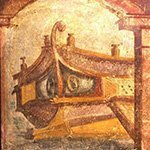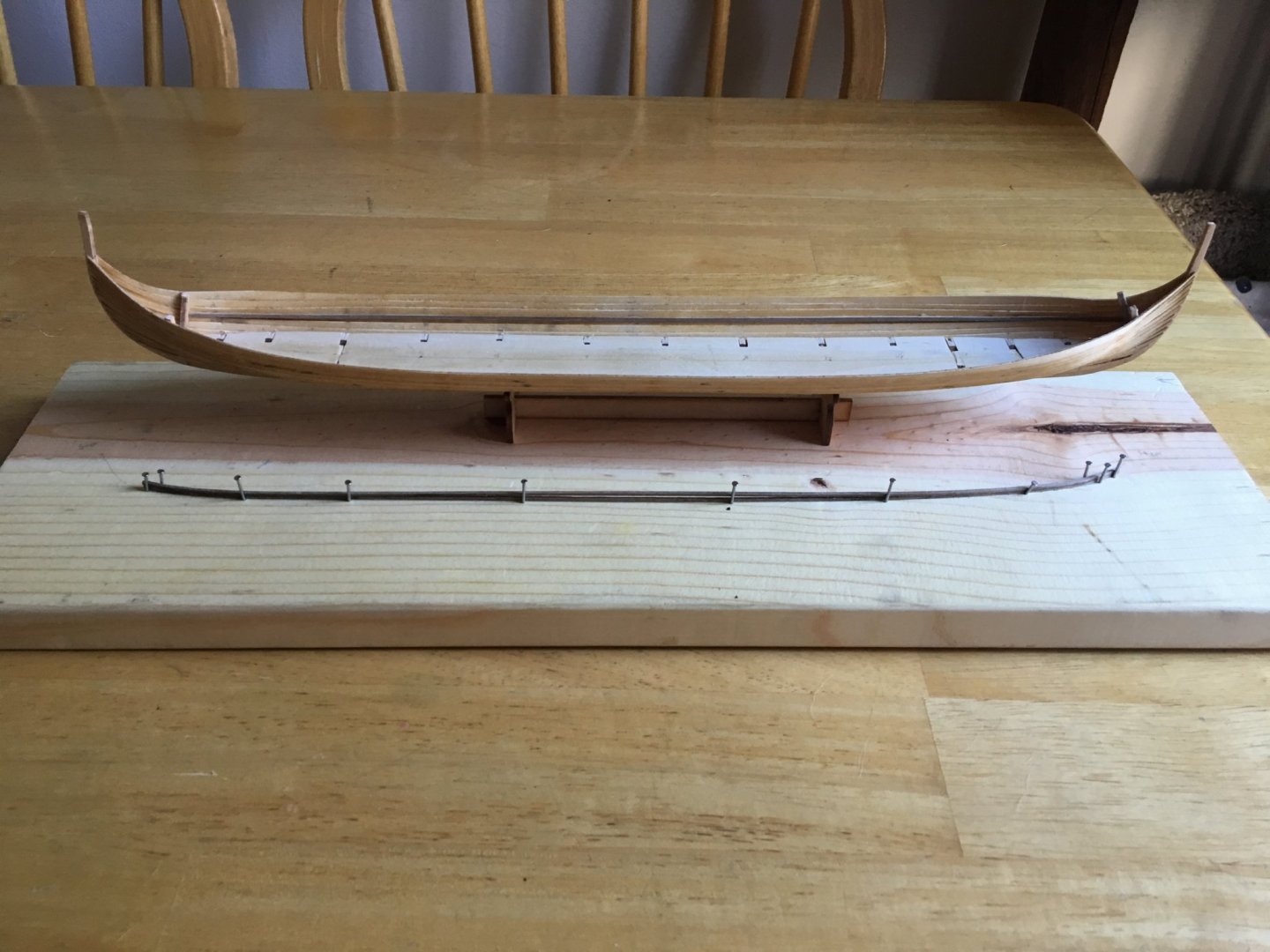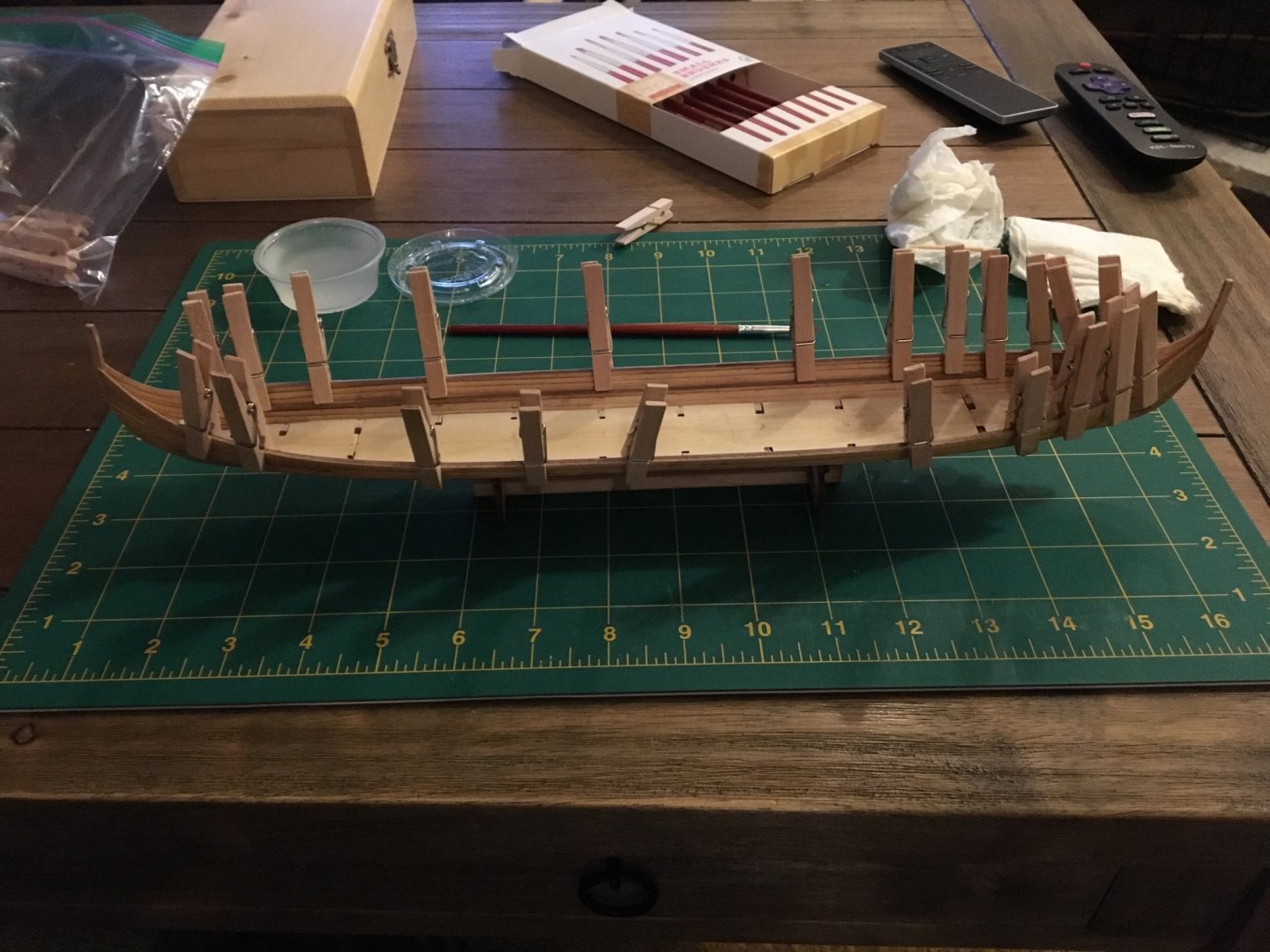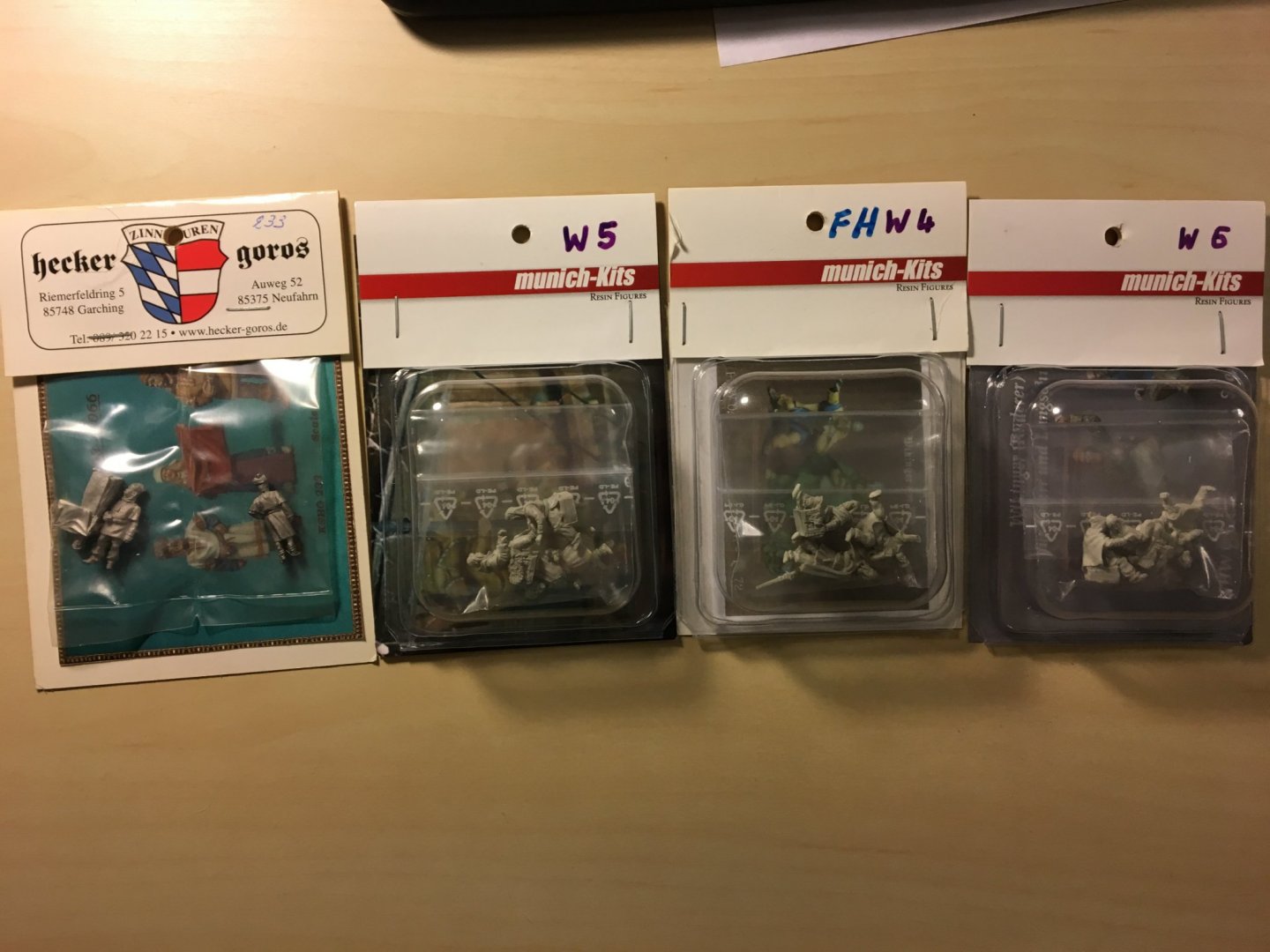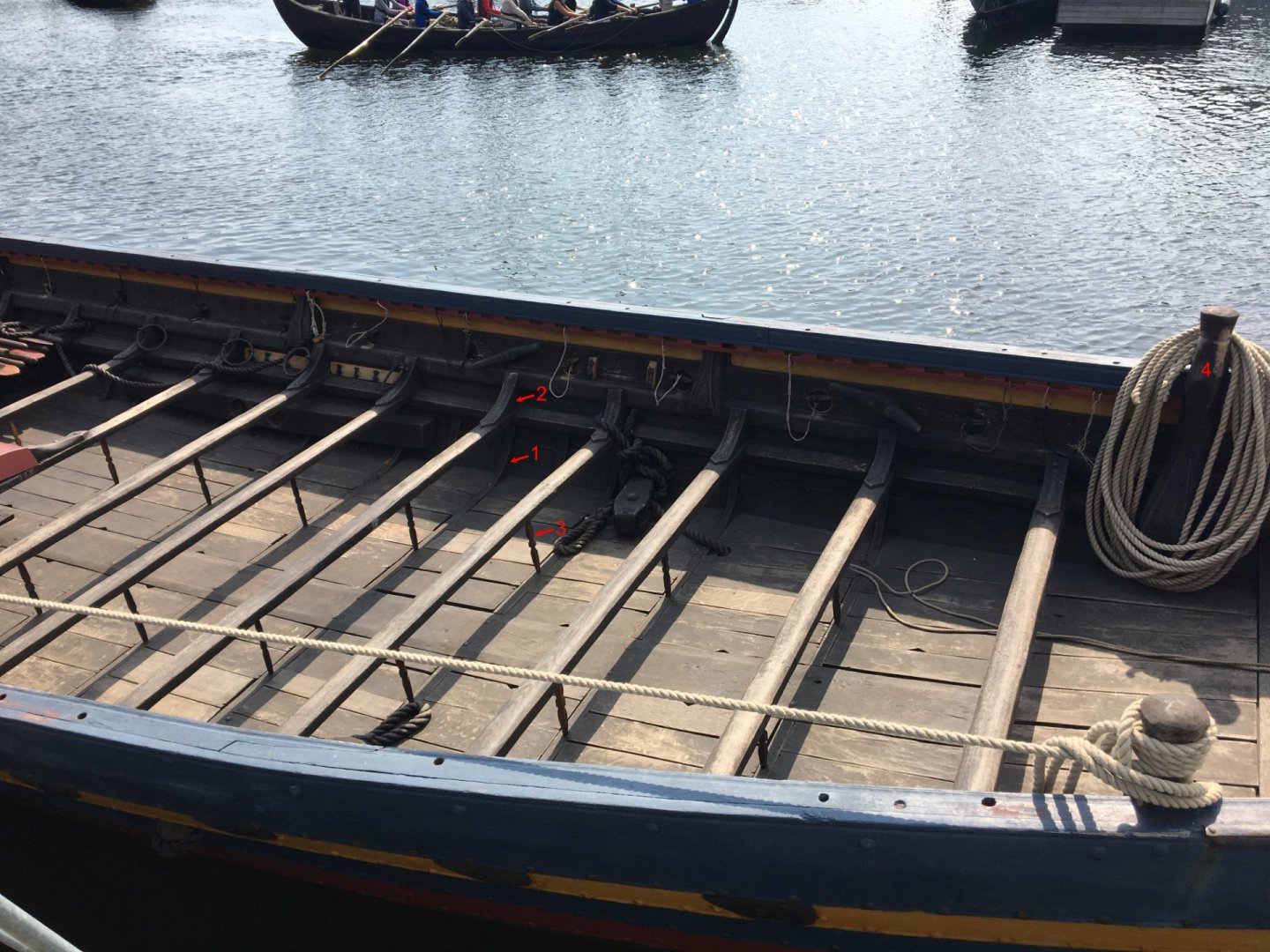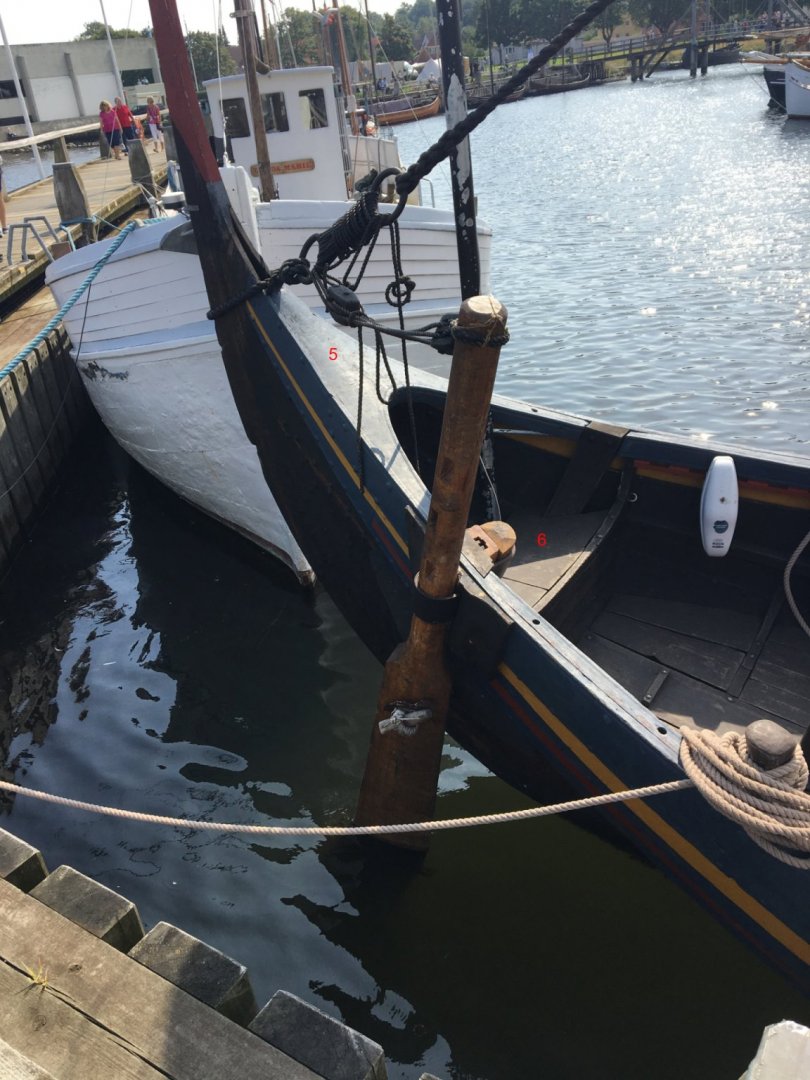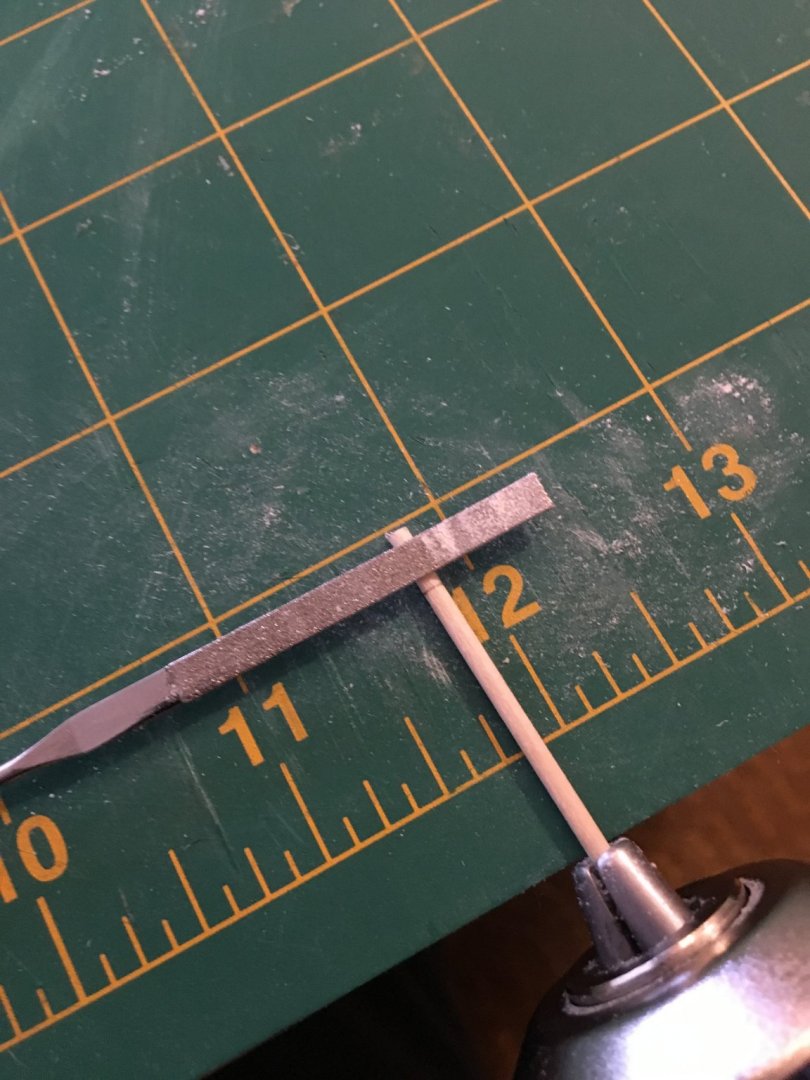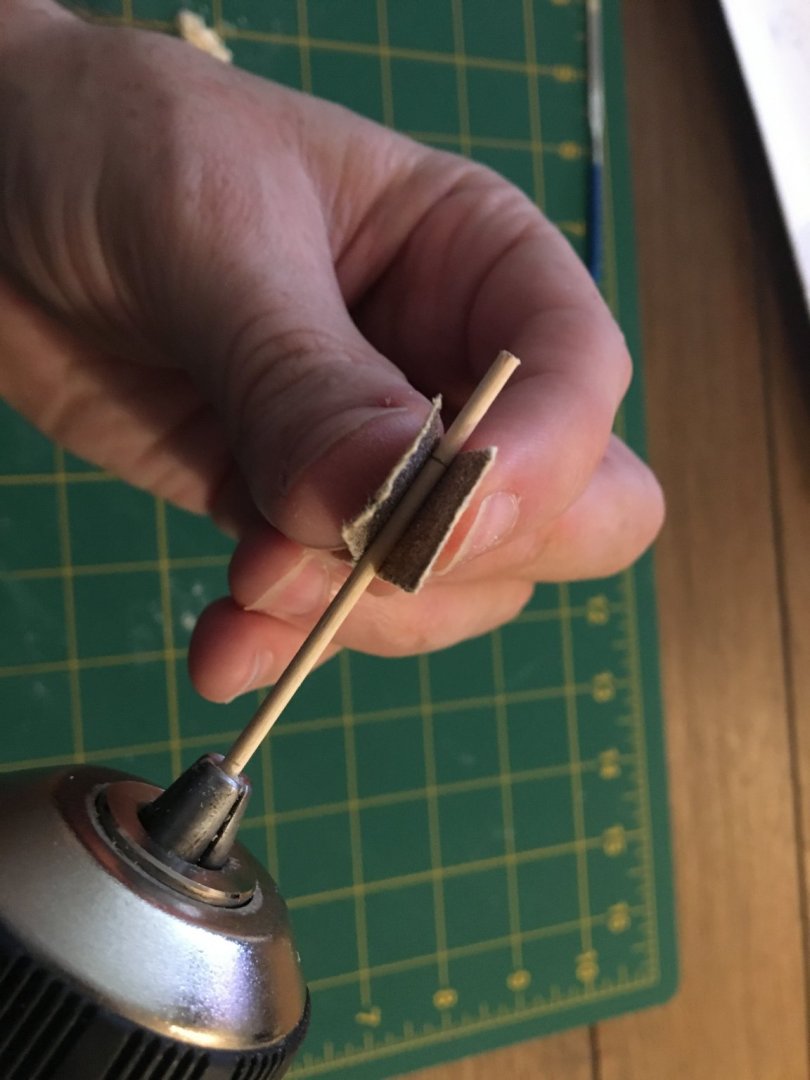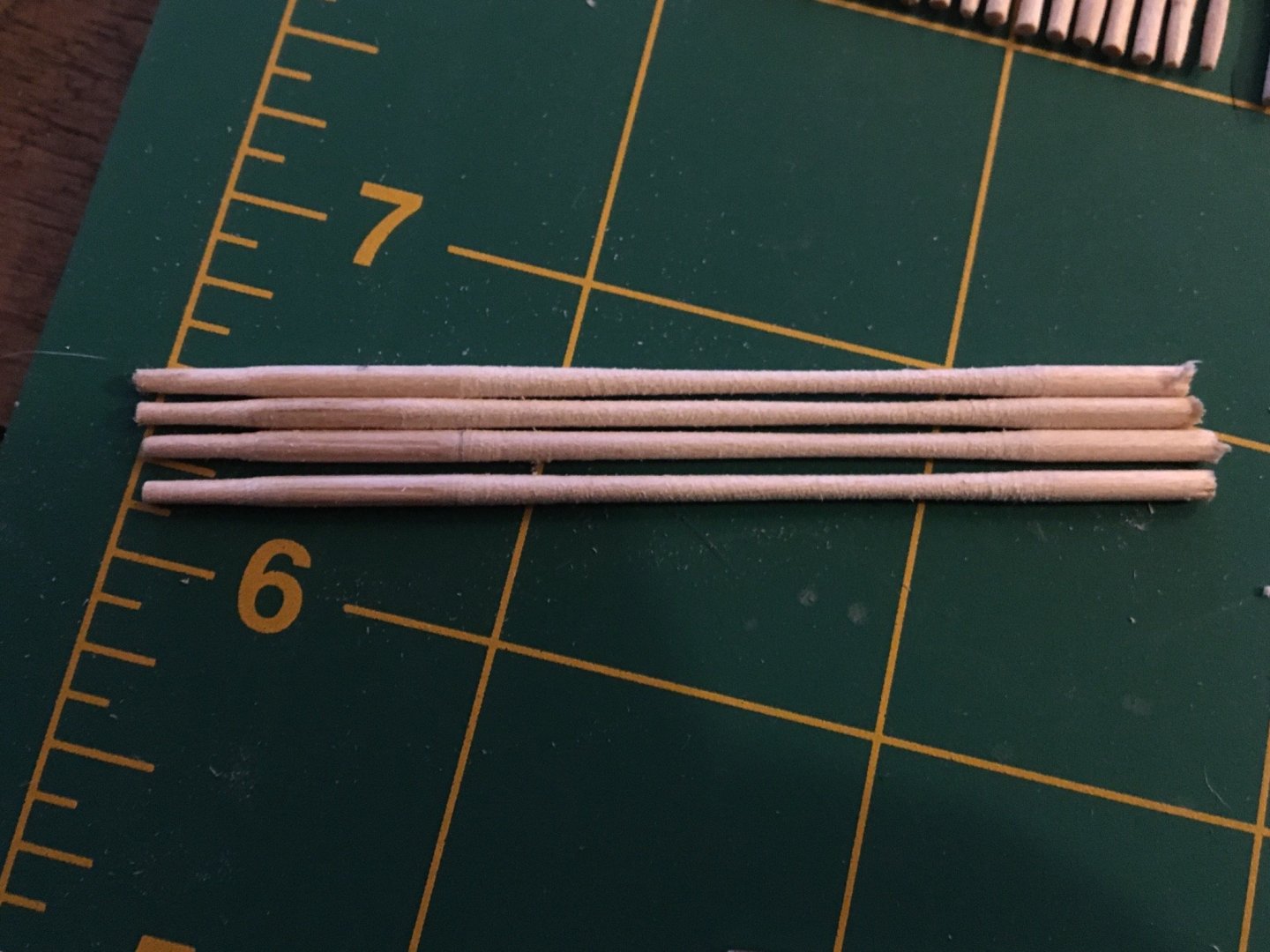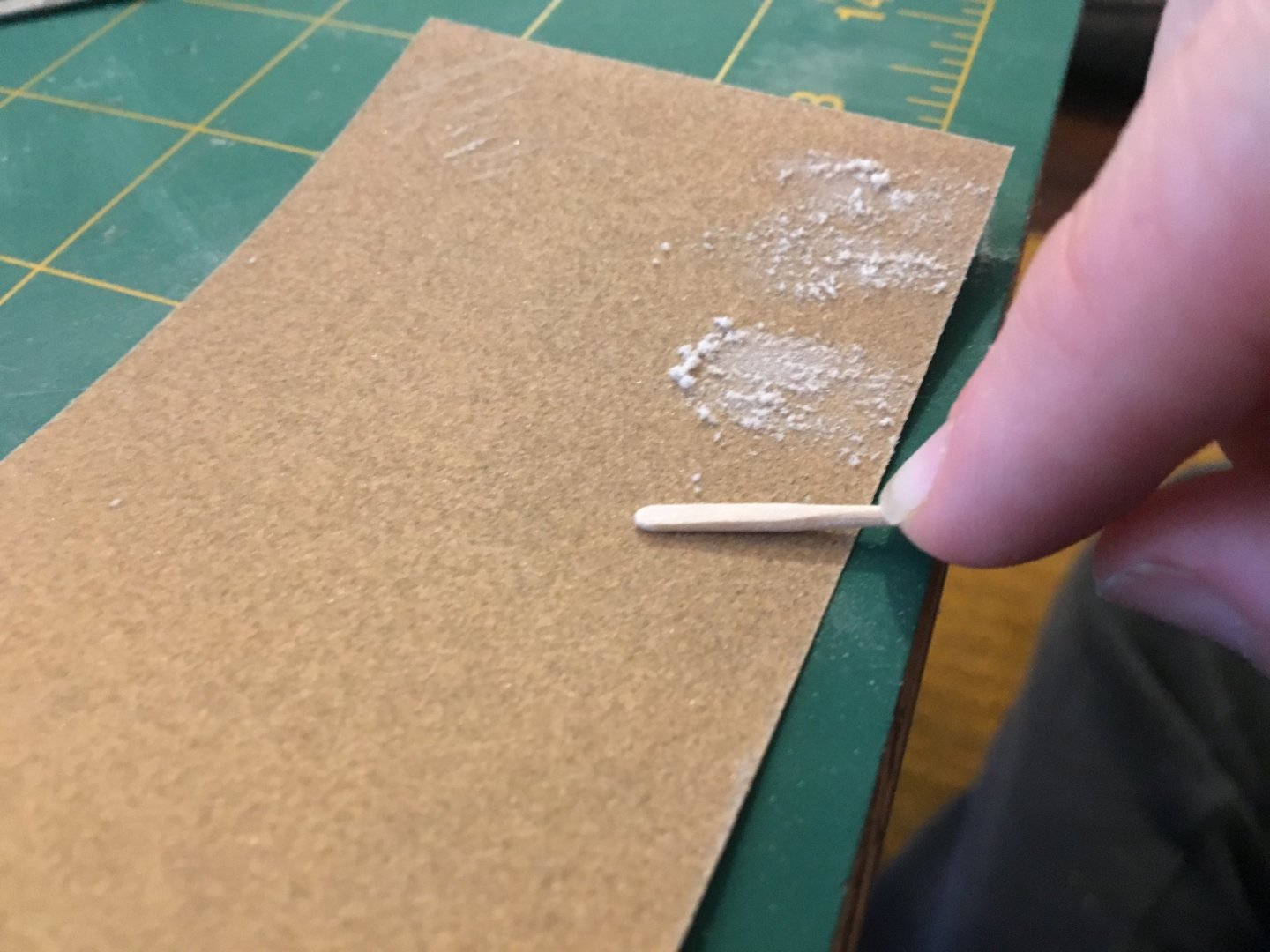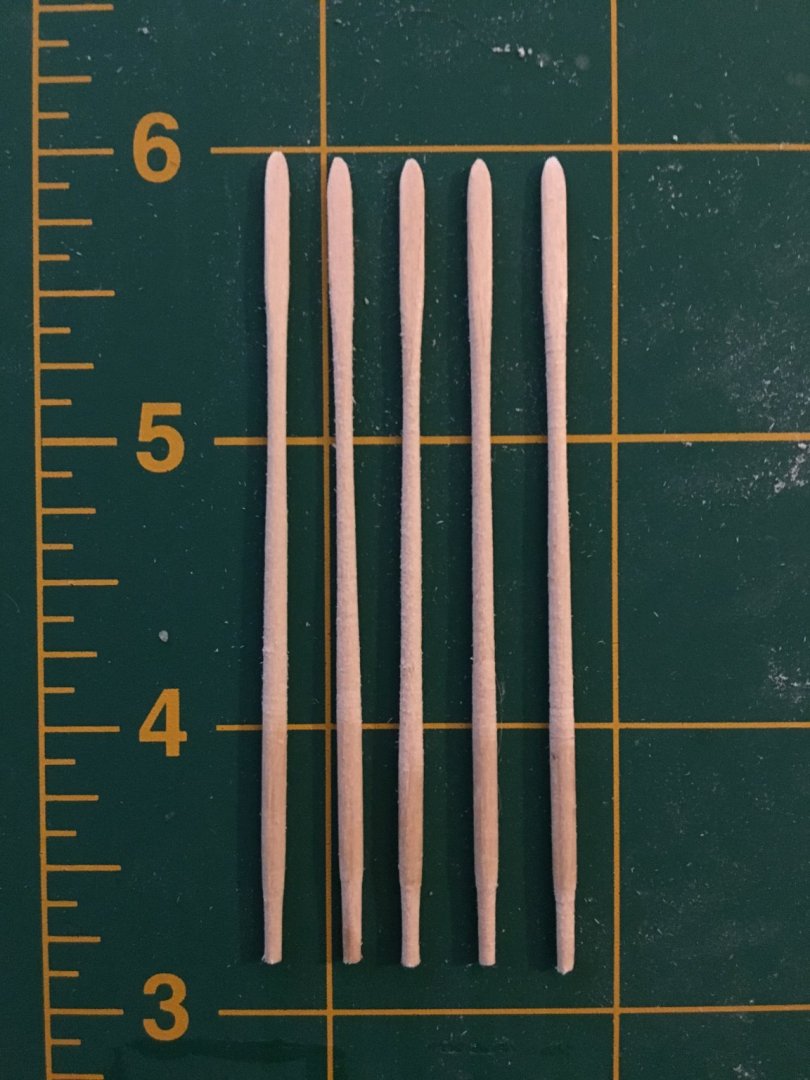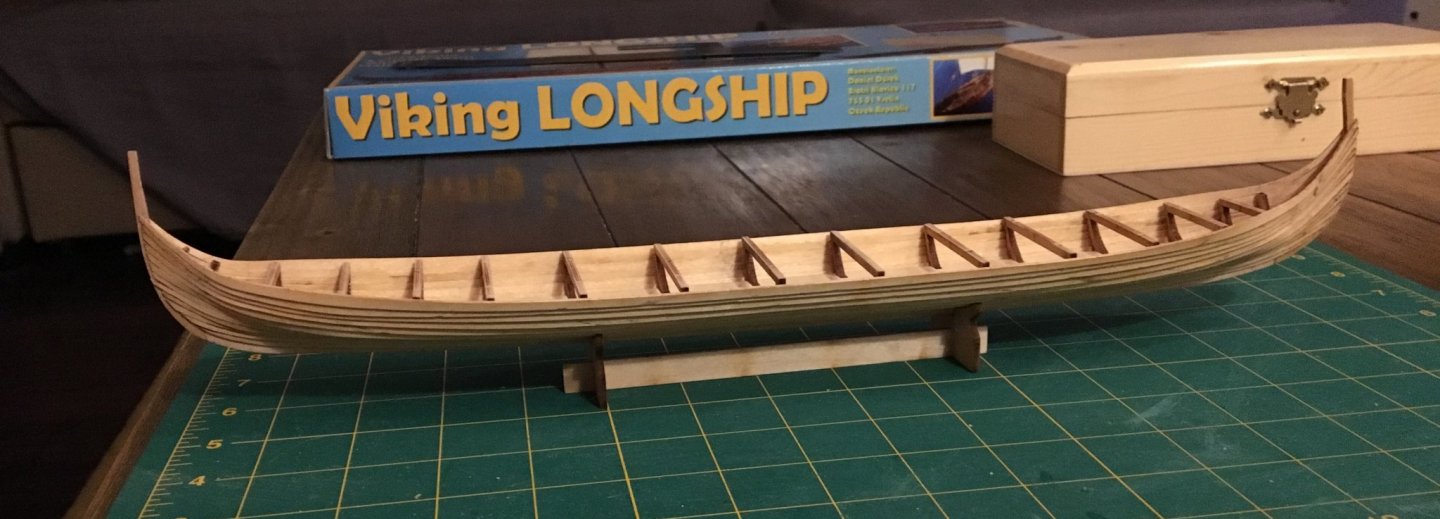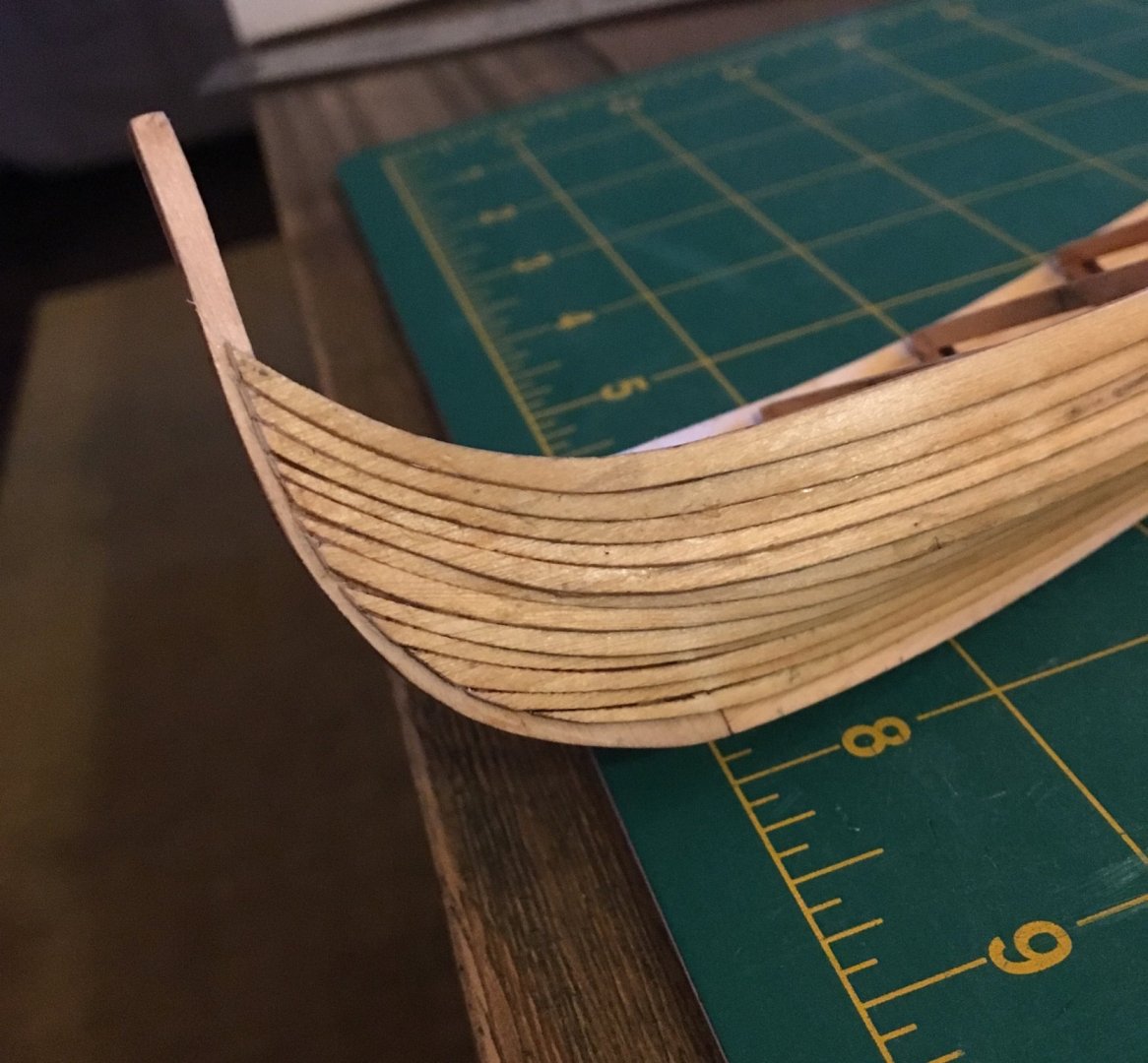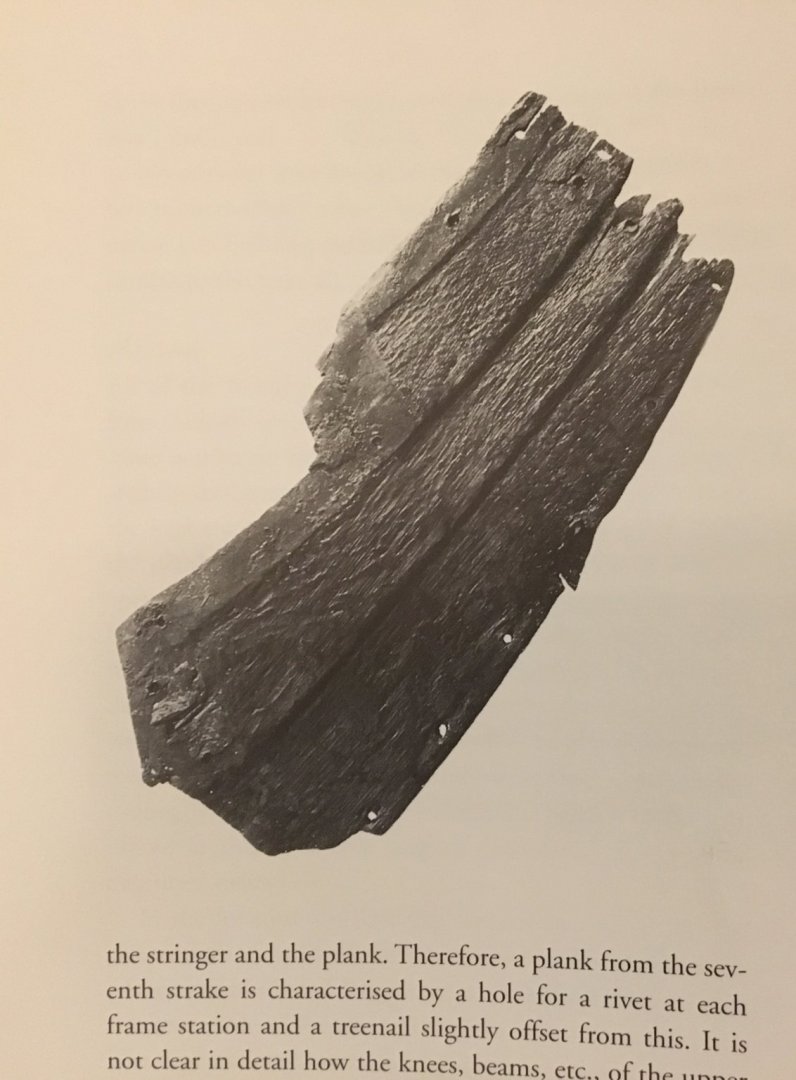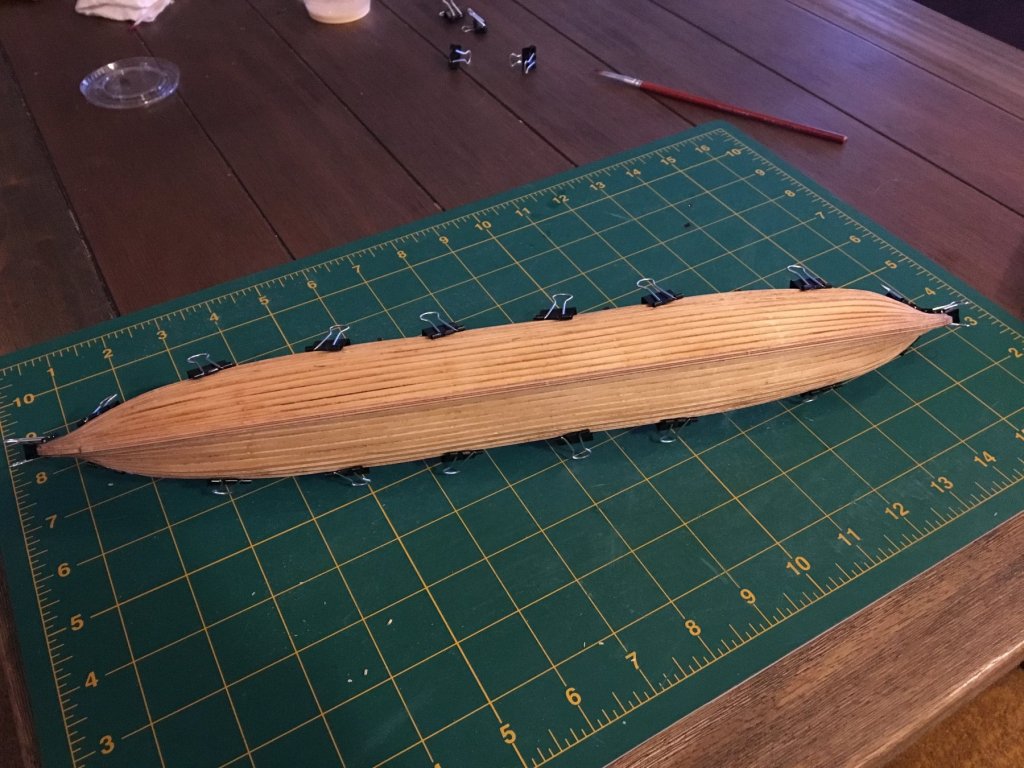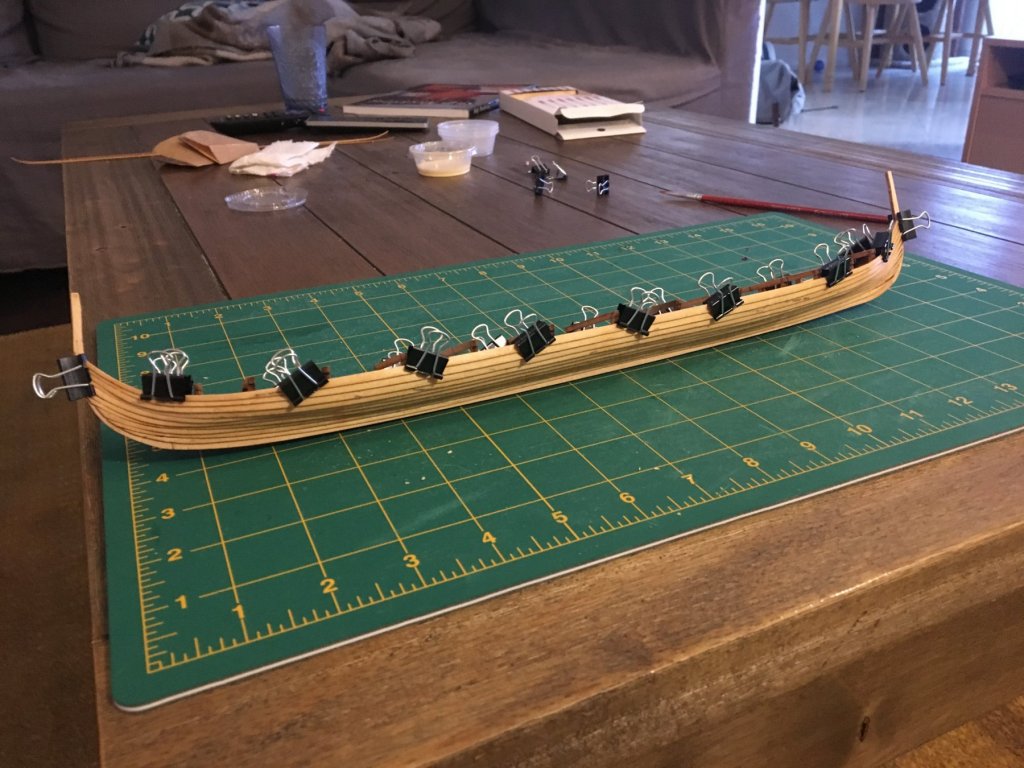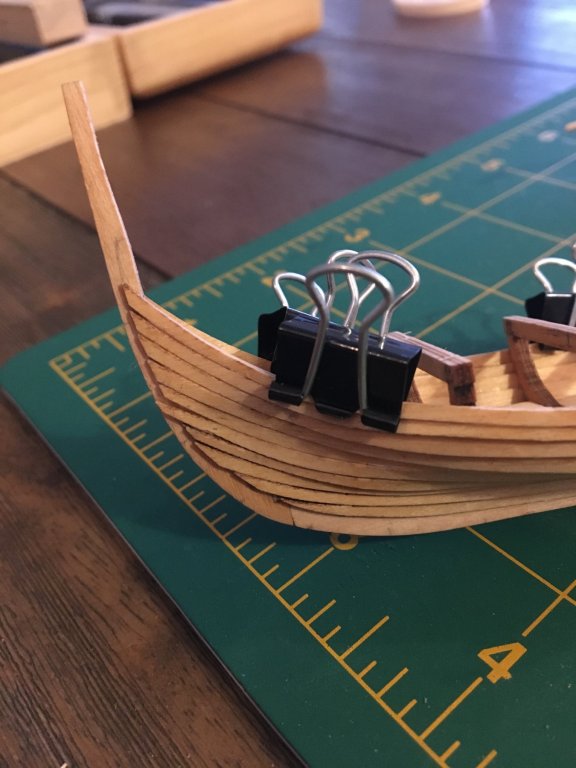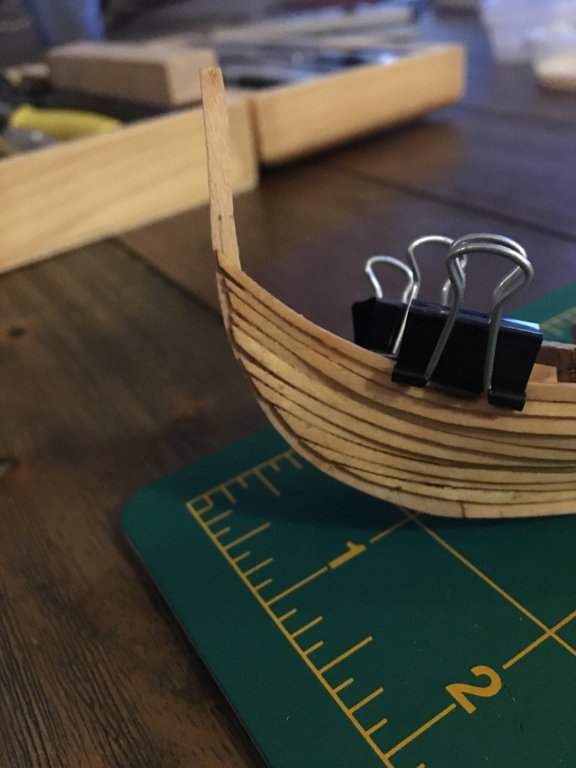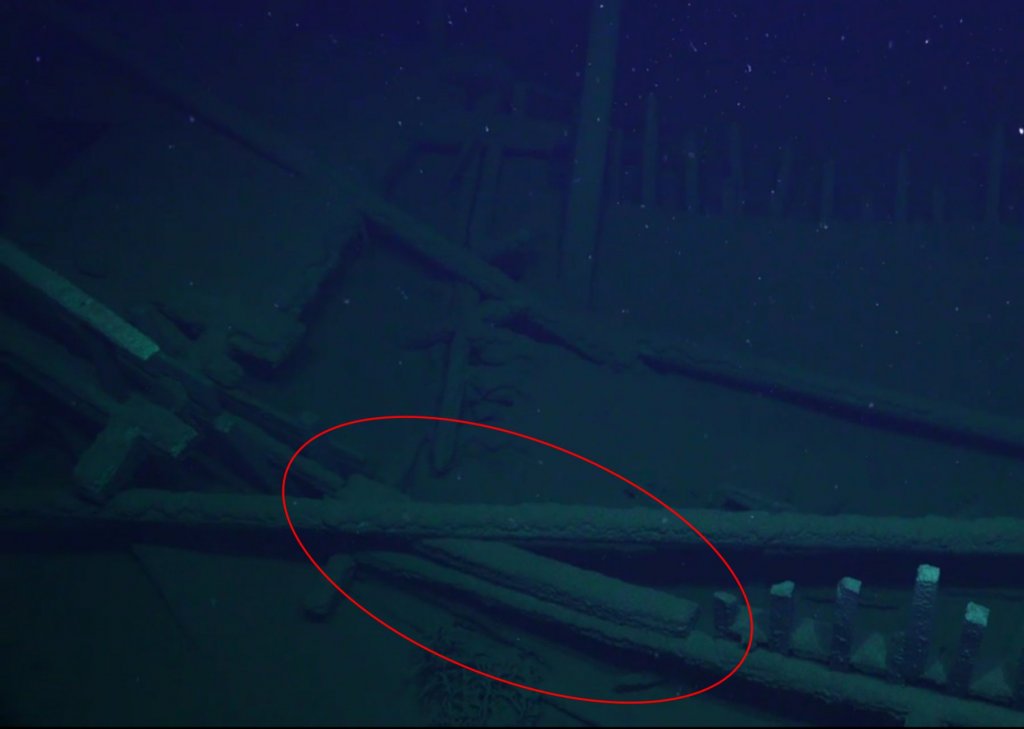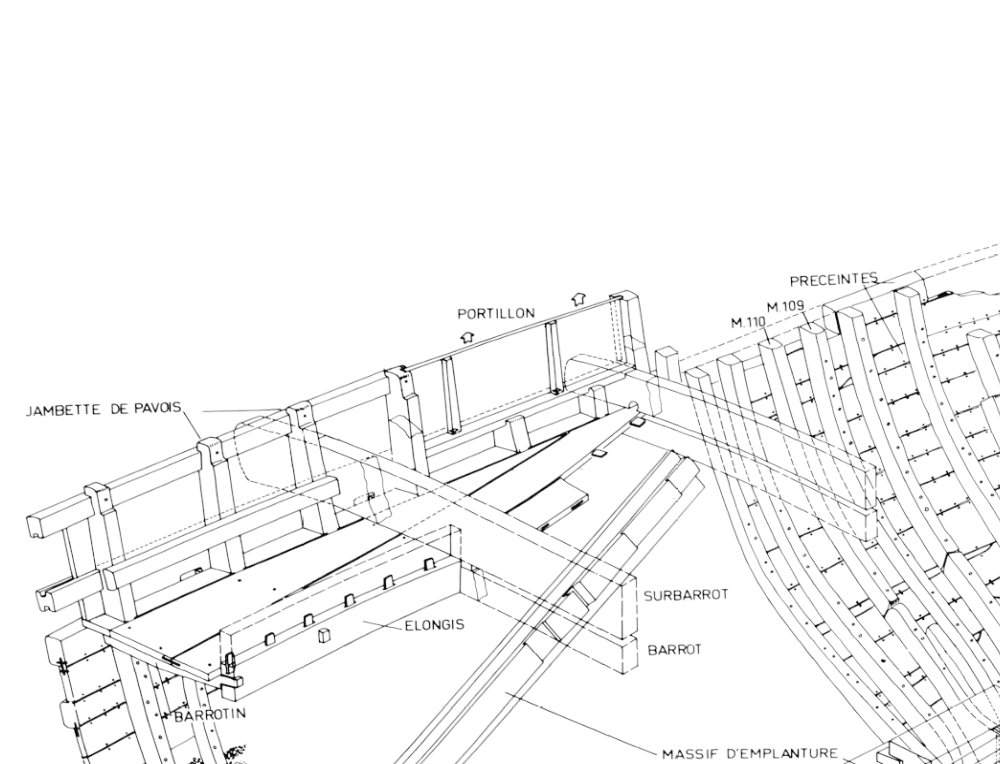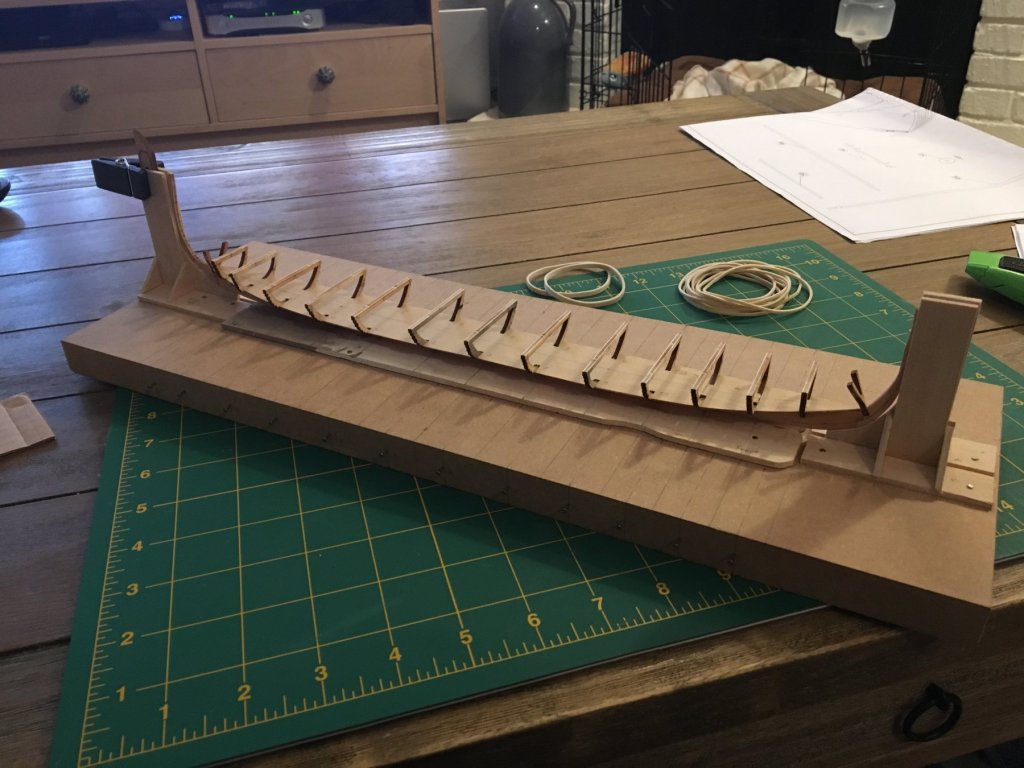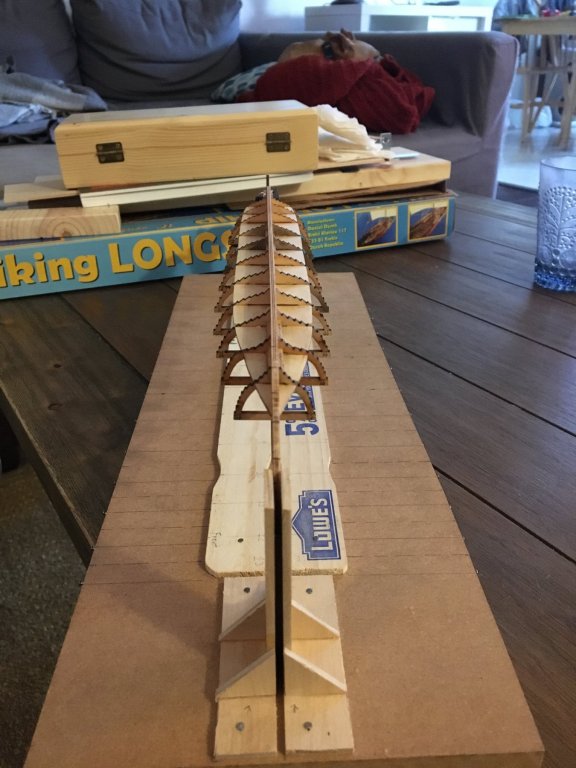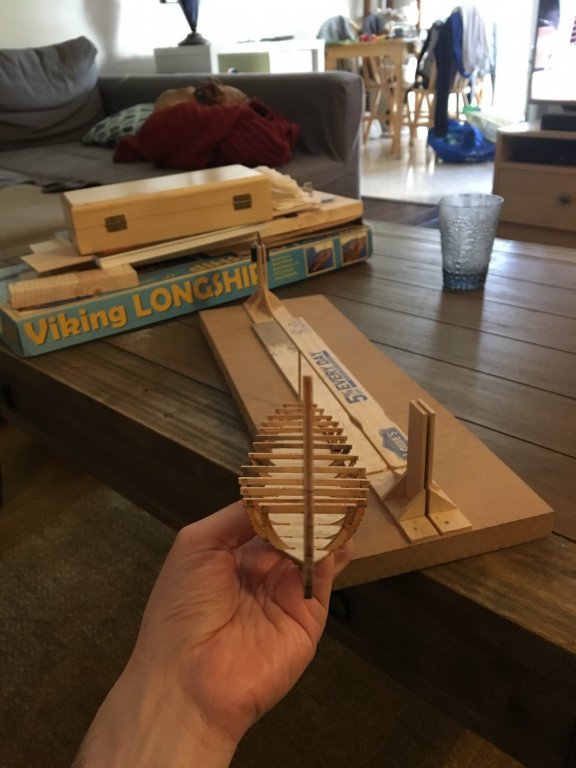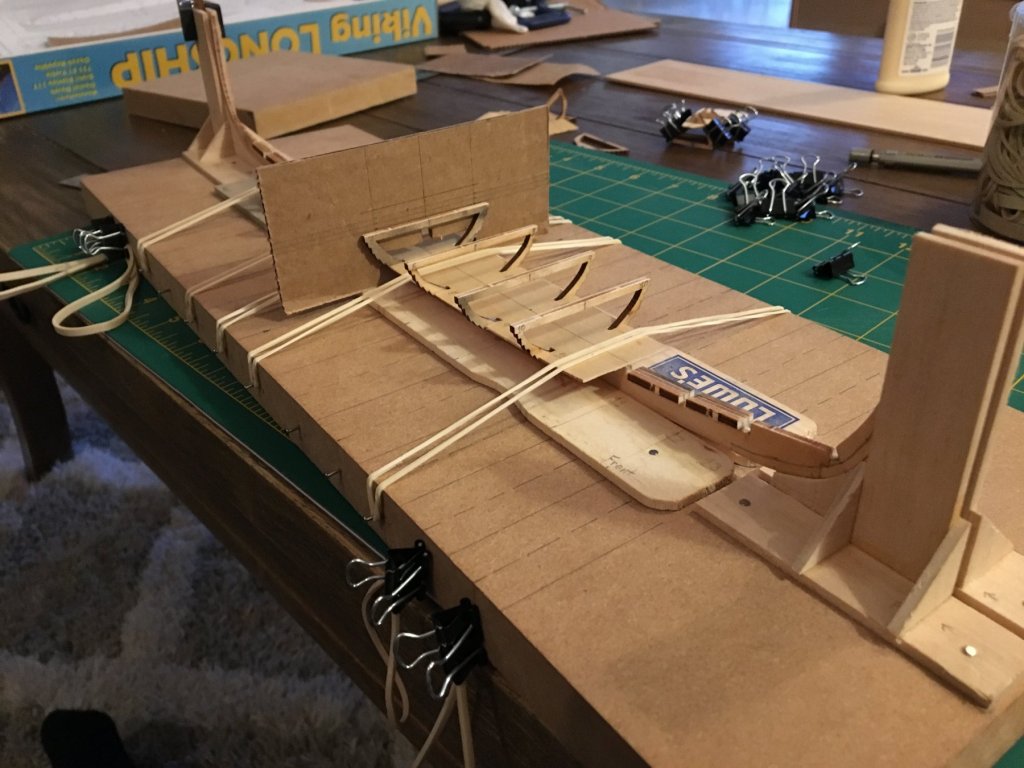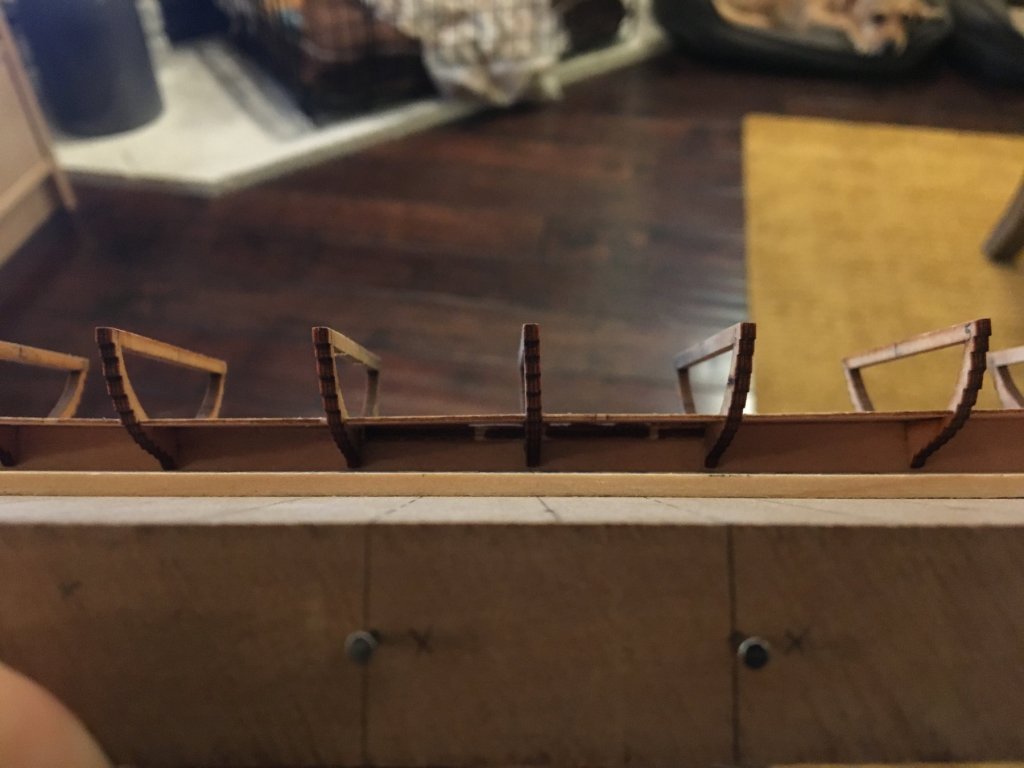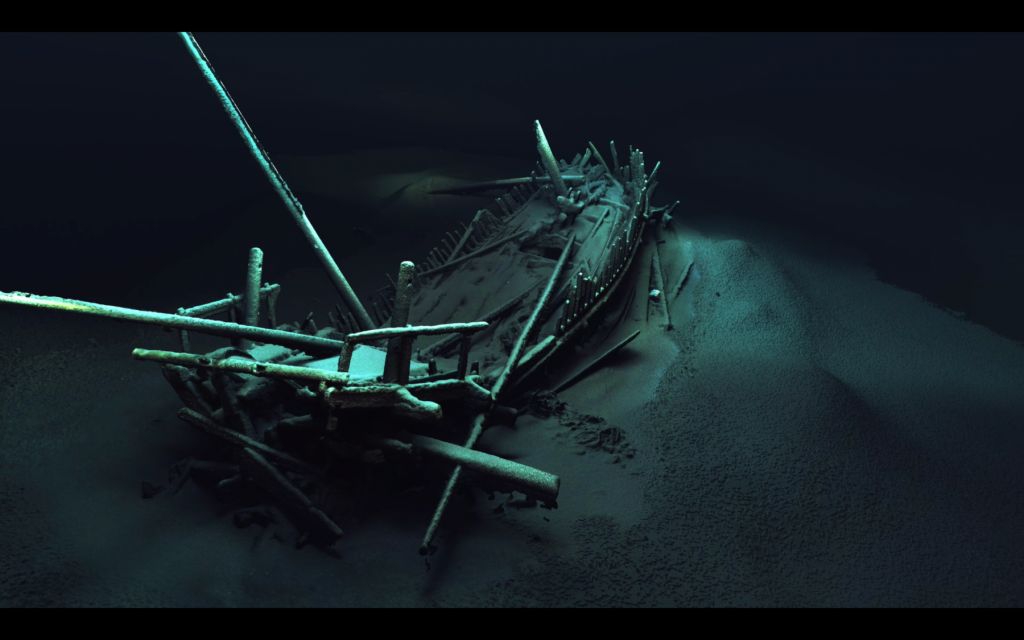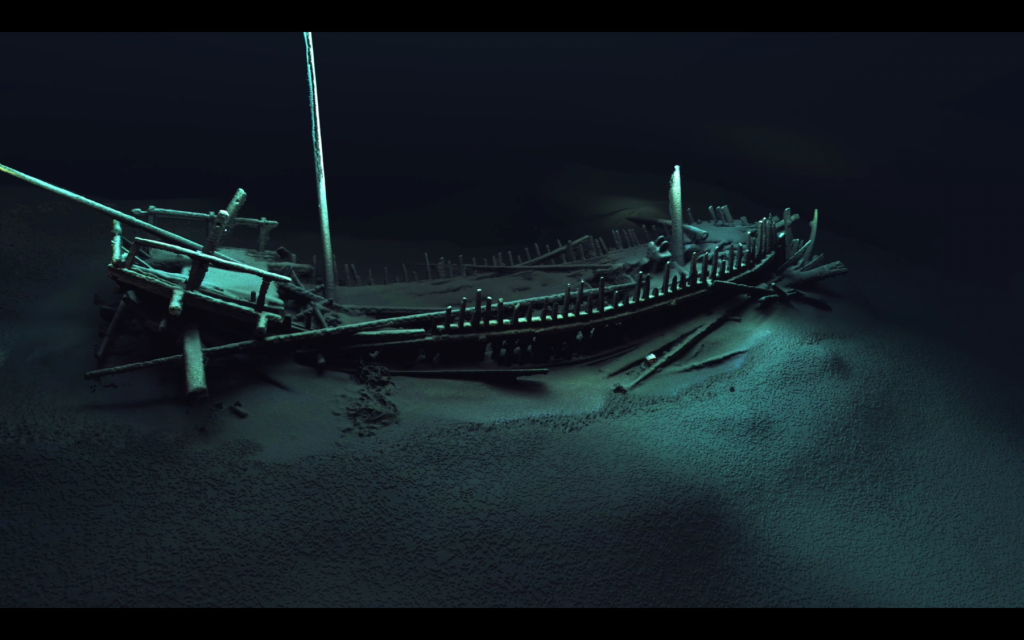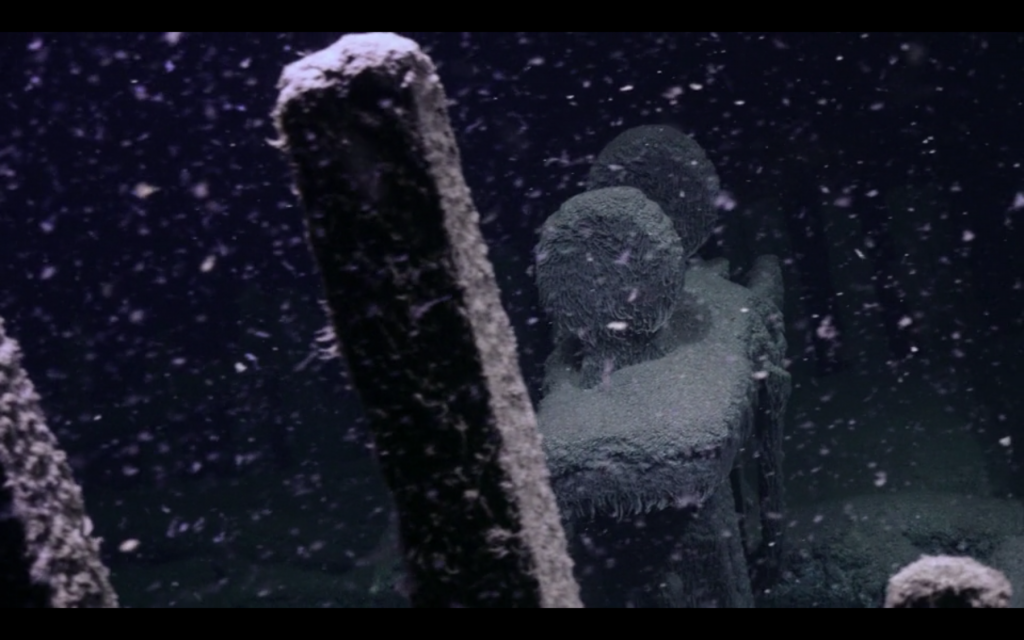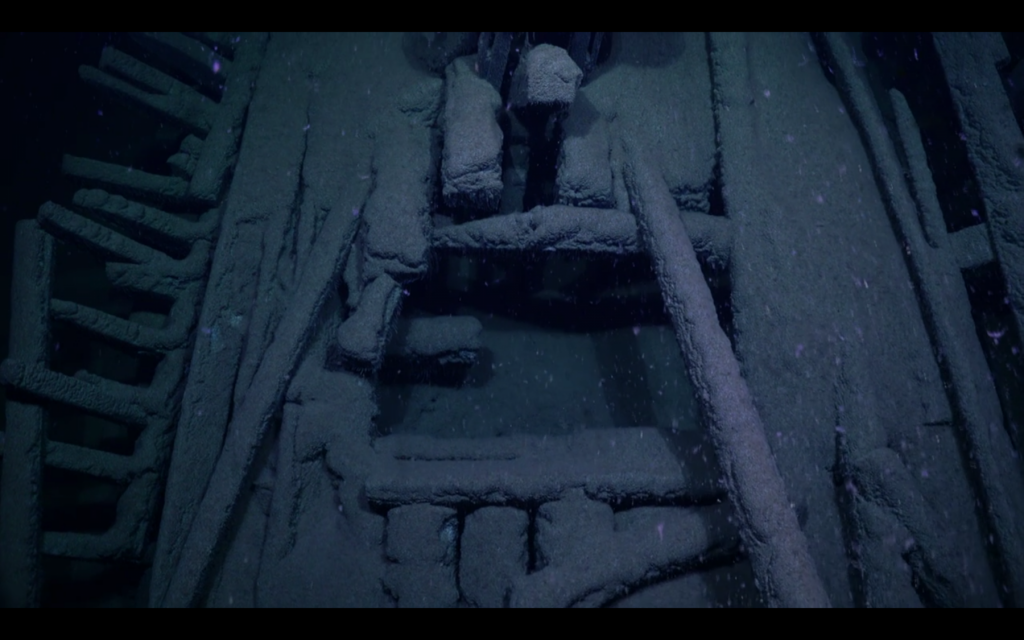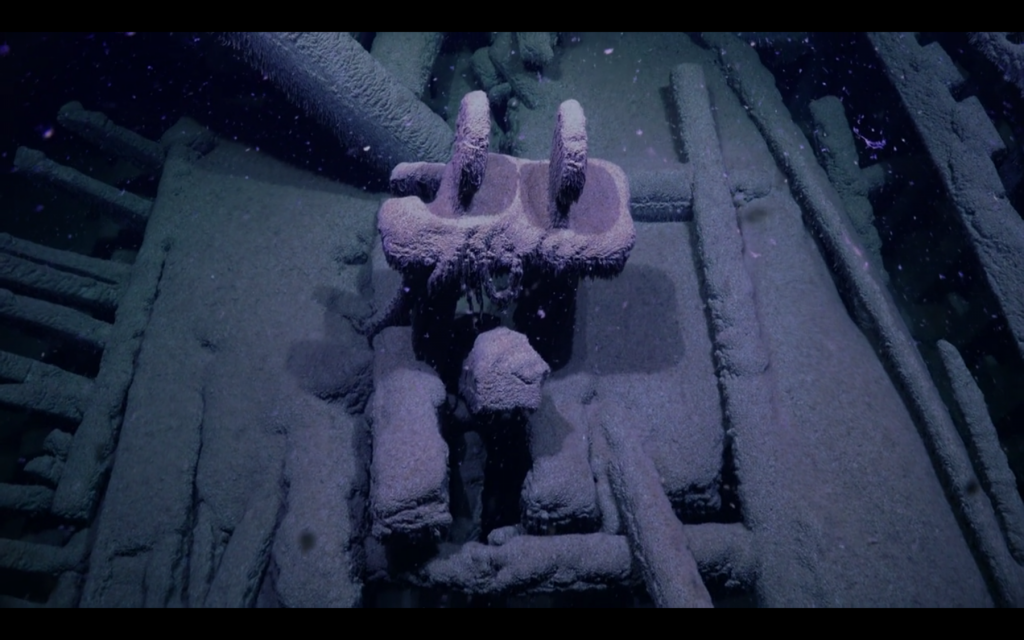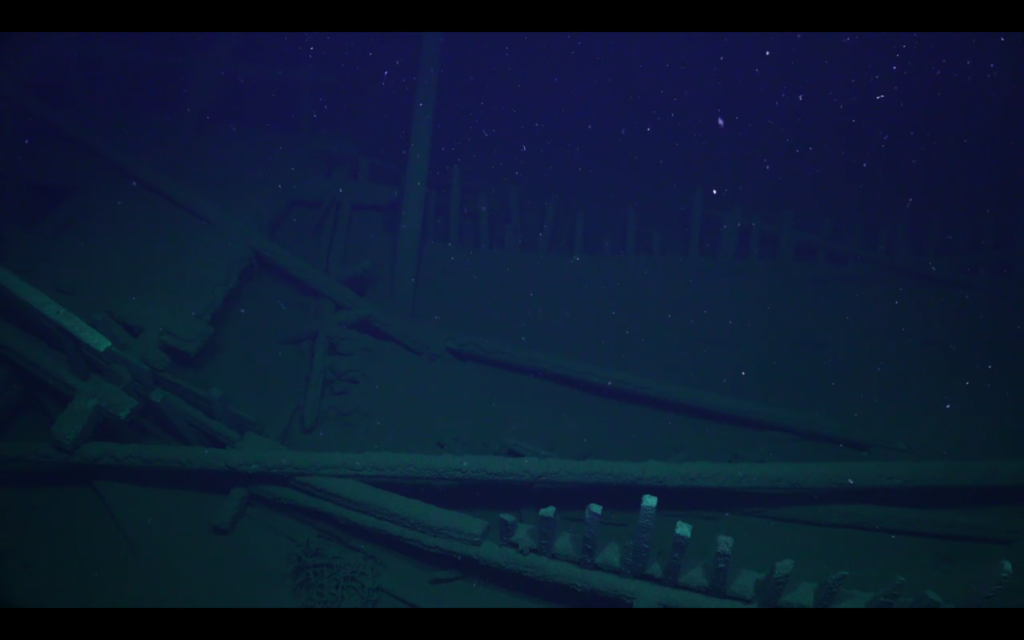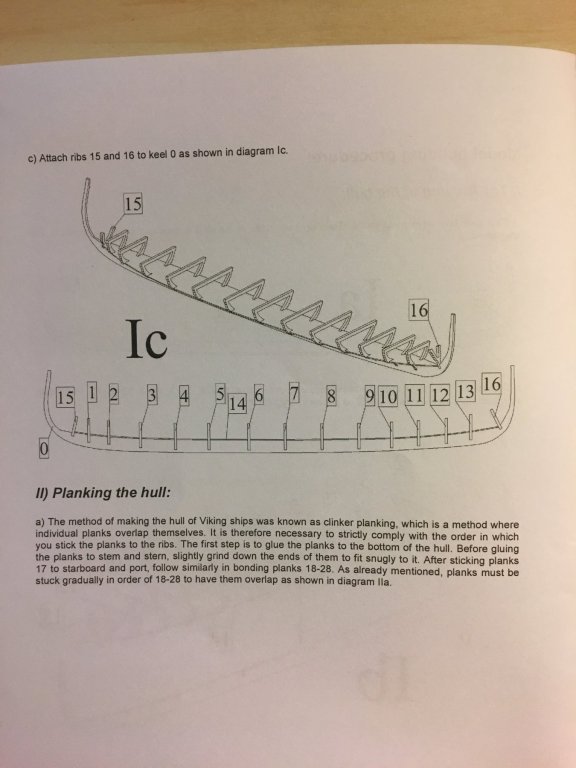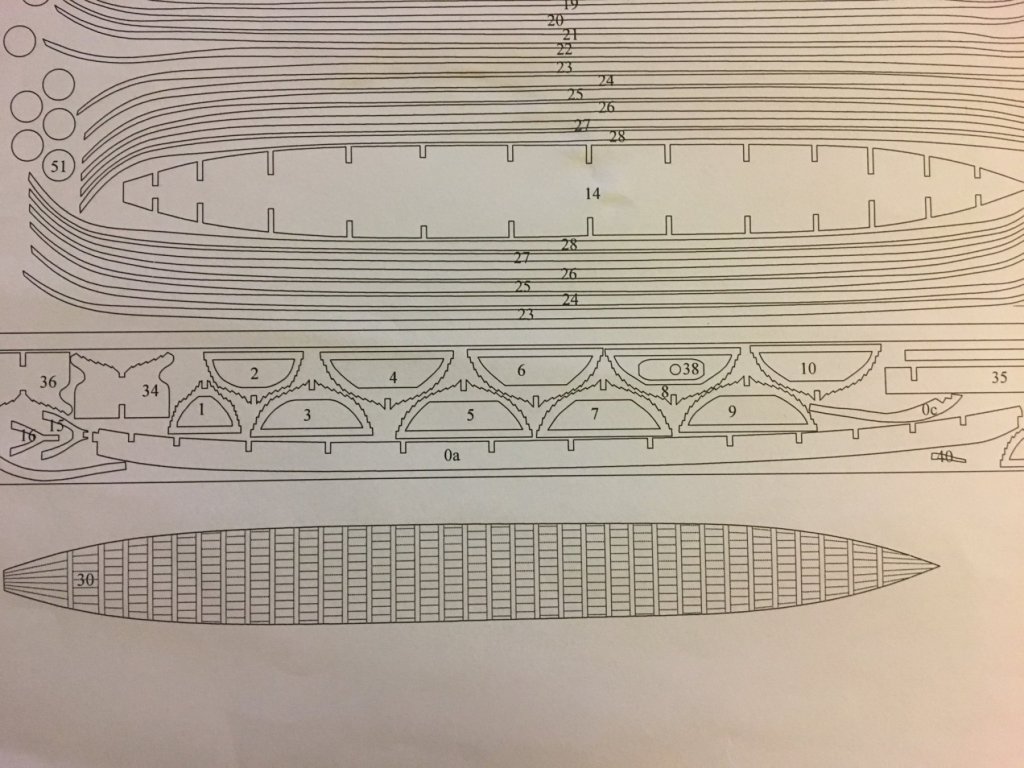-
Posts
151 -
Joined
-
Last visited
Content Type
Profiles
Forums
Gallery
Events
Everything posted by Binho
-
Thanks for the likes, comments, and words of encouragement everyone! Steven great bit of background info on the Mora, thanks! For an older kit it is pretty good, you can see how they tried to adapt the info they had. md1400cs the Amati kit is a very nice model of the Oseberg ship! I’ve seen a couple of them on the forums. Thanks for the links, that Gokstad ship model is amazing! stuglo thanks, I feel like I’ve learned a lot already! The PVA is working pretty well, but I still get nervous about gluing stuff down. It’s true that it least it can be changed and fixed. I am enjoying the hobby a lot so far! Update on progress: Putting in the stringers. Made a bending jig for the top stringers. Glued in top stringers tonight. Also, a preview of some of the 1/72 Viking crew figurines I got from Munich kits and some Vikings from Hecker Goros!
-
That does look like a good book! Added to my wish list. What boats are covered in it? Looks like the Nydam boat on the cover. I have Conway's The Age of the Galley too which is great.
- 45 replies
-
- egyptian
- bronze age
-
(and 1 more)
Tagged with:
-
No problem! Apparently she has been! Probably the best starting point for recreating the Mora would be this kit really. You can bash in the figureheads, and get some kite shields to replace the round shields. Mr. Dusek is really great and helpful, he's probably going to be my go-to for kits. I've been eyeing up his 'bireme' kit too. I wish! I work in commercial archaeology in California. Most of my published reports are for pre-construction archaeological surveys or reports about sites/artifacts found during construction jobs. A lot of local Native American and late 19th/early 20th century historic archaeology. It's mainly compliance stuff to meet California's environmental regulations. My MA was in Roman Archaeology, and my thesis on Hadrian's Wall was published a few years ago in Archaeologia Aeliana (I'm pretty proud of that, haha). Researching naval archaeology is more of a hobby
-
Nika, no need to apologize! There is a lot of bad info out there on Viking ships. That image is another reconstruction of the c. 890 CE Gokstad burial ship, so whoever is calling it the Mora is mistaken. The Gokstad ship has essentially become the standard "Viking Ship" for the whole Viking period in the popular imagination - perhaps because of its exceptional preservation. It was only the second Viking ship found and has been reconstructed numerous times since the late 1800's. Carved dragon heads like the ones depicted in the image were found in the ship, but were not on the stem and stern. They were for tent posts and bed posts. That tent design is hypothetical as well, I'm not aware of any evidence of a tent being used like that on a ship. As a good rule, any resource that uses the word 'Drakar' to describe a Viking ship is immediately suspect. Dreki, meaning 'Drake', is used a few times in Skaldic poetry to talk about warships but is probably a kenning (a figurative descriptive phrase) and not the name for a ship type (source). I suspect 'Darkar' caught on because it has a romantic, mythical, ring to it. The best online source for solid, detailed, Viking ship information that I have found is the website for the Viking Ship Museum in Roskilde. The NAVIS I database also has some good information on Scandinavian ship archaeology. Dusek does a good replica kit of the Gokstad ship in both 1:35 and 1:72 scale. Jack Aubrey did a build log of the 1:35 kit here on MSW that has been very inspirational to me. The original 1882 excavation report of the Gokstad burial is available to read and download here if you are interested. It has great illustrations of the more interesting objects found on board. The ship itself is very interesting on it's own! It was found with 32 overlapping shields painted in black and yellow arrayed along the sheerstrakes, but there was no evidence of how they had originally been attached.
-
Cool kit and subject Nikiforos, following with interest
- 45 replies
-
- egyptian
- bronze age
-
(and 1 more)
Tagged with:
-
Hey Nikiforos, unfortunately that kit does not seem to be period accurate for a ship from the Norman conquest. The design seems to be inspired by the earlier Gokstad (~890 CE), Tune (~900 CE), and Oseberg (~820 CE) burial ships from Norway. In 1066 a longship like the Mora would probably look a lot like Skuldelev 2 and the other longships I was discussing above. Specifically, other images of this kit I found online show a flatter bottom to the hull, like on the earlier ships, and not the more rounded profile of Skuldelev 2. The biggest giveaway though is the lack of thwarts/rowing benches and the exposed mast step. These are design elements taken straight from the Oseberg and Gokstad ships. The lack of rowing benches on those earlier ships is always something I've found strange. A popular theory I've seen is that on 9th century ships the rowers sat on sea chests. That doesn't seem to be like a particularly good way to row to me - I could easily imagine the chests moving with the motion of the ship and the movements of the rowers. I'm not sure what the source for the sea chest theory is (does anyone know? I'm assuming it's from a Skaldic poem). Since it's only the burial ships that lack fixed rowing benches, I've always wondered if this was just because they were purpose built for burials. It wouldn't be easy to fit all those grave goods on a ship with rowing benches. However, it appears there are some traces of use wear on the burial ships. Norwegian archaeologist Knut Paasche wrote his PhD thesis on the Tune ship arguing that it was not just ceremonial, but the thesis isn't available for download. This is the only english summary of Paasche's thesis I could find: https://www.newsinenglish.no/2011/05/09/viking-ship-not-just-ceremonial/
-
That was a fast build, but it came out very nice! I like it Barry, I like the dark stain too. Might try that dark walnut for my Viking ship as well. It looks like the shield rack they provided is based on the rack found on the Skuldelev 5 longship. Interestingly if shields were placed in the rack on that ship, they would have blocked the oarports. So at least on that ship, if they did use the rack for shields they couldn’t put the shields out while rowing.
-
Very cool! What will the software simulation be used for? I’m sure I wouldn’t be the only one interested in the results! I’m curious how they made the ram for Olympias too. I have their book The Athenian Trireme but it doesn’t talk much about the ram. Casting a 200kg bronze ram can’t have been cheap. Though if they were trying to be as accurate as possible, making it out of plate would be strange.
-
My jaw is firmly on the floor. This is amazing, and a great subject too! Your technical skill and precision are next level! What are you going to do for the ram? Are you going all the way out and casting it in bronze? Are you sticking with the ram design they used on Olympias or going with one of the more recently found trireme rams?
-
Oh wow, I actually thought the Dromon had a greater L/B ratio. I guess that's not too surprising though since it would need to fit oar crew on two decks. Interesting how much narrower the Viking longships are then. I hadn't really considered about the possibility of breaking its back, but now that I think about it it is pretty amazing. Especially since the hull planks were no more than 2.4 cm thick, and the keel was so heavily worn it was only 6 cm tall by the time the ship sank. The planks on the ship were also very wide and very long, between 25-37 cm wide and over 10 meters long. They estimate there were probably only 7 strakes. By comparison, Skuldelev 2 had about 12-13 strakes, with planks 2.5-2.8 cm thick, 20-26 cm wide, and max 6.5 meters long, and a keel that was originally 16-17 cm tall but was worn down to 14 cm when found. The keel wear is likely from beaching the ships. In terms of stringers, the reconstruction cross section for Haithabu 1 shows two thick internal stringers, but it's unclear from the sources if these are hypothetical or if they actually found traces of them: Internal stringers were found in all the Skuldelev ships, so it's likely Haithabu 1 had them as well. I don't think wales are known from any Scandinavian ships, only internal stringers. The Skuldelev 2 wreck has parts of the lower stringer intact, and the reconstruction has three (you can see them in my photos in one of the previous posts). The model kit has two stringers. These ships would have also had a hefty keelson with a bulbous mast step, the one in Skuldelev 2 being 14 m long and almost entirely preserved (you can see it in the hull line drawing a few posts back, along with the stringer remnants). My sources for Haithabu 1 are the NAVIS Database ( https://www2.rgzm.de/navis/ships/ship008/Ship008Engl.htm ) and the Viking Ship Museum website ( https://www.vikingeskibsmuseet.dk/en/professions/education/viking-knowledge/the-longships/findings-of-longships-from-the-viking-age/the-longship-from-haithabu-harbour/ ). The latter has sections for other longship finds, as well as sections for all the other Skuldelev ships. EDIT: Oh yeah, another interesting factoid about Haithabu 1 is how it met it's end. It appears to have been floated out to the middle of Haithabu harbor and set on fire sometime between 990-1010! The current theory is it was used as a fire ship while defending the harbor from a raid. There is obvious charring on the top of the 4th strake, so the ship probably burned down to the waterline before sinking.
-
Yup, the research is definitely half the fun It's great to learn new stuff and speculate! Part of the fun of being an archaeologist is the speculating, haha. Actually, ships this long are archaeologically attested from around this period! Funnily enough, in 1996 when digging foundations to extend the Viking Ship Museum that contains the Skuldelev ships they encountered multiple other Viking ships. The most impressive is the Roskilde 6 which is still not fully published, as far as I'm aware. It was displayed in the British museum in 2012 after conservation was finally finished. Dendrochronology put its build date in 1025 CE. The three-piece keel is fully intact and on its own measures an impressive 32 m, so the complete ship would probably be around 36 m. As the distance between the ribs are about 80 cm, they estimate there would have been about 39 rowing benches, for an oar crew of 78! Interestingly at 3.7 m wide it's also slightly narrower than the 3.76 m wide Skuldelev 2. Another interesting long ship find is the Haithabu/Hedeby 1, dated to 985 CE, so around the time of King Olaf. It is the narrowest long ship found to date, at only 2.7 m wide, but is estimated to be about 30.9 m long giving it a L/B ratio of about 11:1. It's also the most elaborately decorated and carefully built longship found so far, with decorative mouldings and intricate scarph-joints. Here's a reconstruction drawing of it:
-
Thanks for the comments Nikiforos! I definitely agree there is a lack of good kits of ancient ships. Especially considering how much archaeology there is out there. You'd think most manufactures would at least have kits of the Kyrenia wreck, or some Roman merchantmen or something. Not to mention galleys and polyremes! Thanks Steven! I'll definitely think about adding more fiddly bits, I was trying to keep it a little simple because it's my first attempt at carving. Might as well give it a shot though It sounds like the authors are perhaps better naval archaeologists than they are historians! But I think I've been doing a poor job of representing their work on here. Their Byzantine remark was just a passing comment, they don't give it much serious discussion. It struck a chord with me because when I visited the Viking Ship Museum and saw the Skuldelev 2 reconstruction I had been reading up a lot on Greek and Roman polyremes and medieval galleys. Previously, the only Viking ships I was familiar with were the earlier Oseberg and Gokstad burial ships, which are significantly wider and with a much more pronounced flat bottom. The Skuldelev 2 to my eyes had the proportions and hull lines of a Mediterranean-style galley, albeit with some Scandinavian flourishes. As I knew about the Varangian Guards and the Norman adventures in Sicily, I personally wondered if there had been some Mediterranean influence on Viking ship-building. I found it interesting to see a small nod in that direction in the archaeological report about the Skuldelev ships. One of the significant aspects of Skuldelev 2 is how different it is to Viking ships from the 9th century, such as the Oseberg, Tune, and Gokstad ships. Those older ships are arguably not even actual longships, having length to breadth ratios of only 4.2-4.7, as opposed to 10-11th century warships like Skuldelev 2 which have L/B ratios of between 7.3-13.1. The current theory is that before the 10th century, Scandinavian ships were multi-purpose. The 10th century saw a differentiation of ship types based on function. This is where my previous quote about Alfred the Great comes in, with that being the first historical reference to a ship in the North Sea region with the same parameters as Skuldelev 2. This suggests that there may have been some design exchange between British and Scandinavian ship builders at the time and that the 'true' longship may have British origins. In fact, the only known use of the word 'longship' from this time period is in that passage I quoted above from the Anglo-Saxon Chronicles, specifically describing Alfred's new type of ship as a langscip. In official use the specific name for this type of ship in the British Isles appears to be scegd, and the Scandinavian skaldic poems of the 10th and 11th centuries call the most prestigious type of warship a skeid. Some English sources even refer to a Viking as a scegdman. The change in hull shape is actually quite significant. At the top are the reconstructed hull lines for Skuldelev 2, and in the middle is the Gokstad ship. The plans aren't to scale relative to each other, Skuldelev 2 being 30 m long and the Gokstad ship only 24 m, but note how straight the middle of Skuldelev 2 is and how much rounder it is in section than the Gokstad ship. You can clearly see the stylistic evolution from one to the other in profile, but in terms of the actual hull geometry to me personally Skuldelev 2 bears some noticeable similarity to Mediterranean galleys. Again, I don't have any concrete evidence for that, the similarities could just as easily be down to convergent evolution. In terms of section and plan, to me the Gokstad ship looks a lot more like the 14 m Skuldelev 3 cargo ship than it does the Skuldelev 2 war ship. In regards to Harold Godwinson, it appears I skimmed the chapter too fast and confused Harold Godwinson with his son Godwin(e). Oops! From the archaeology and dendrochronological analysis we know that Skuldelev 2 was built around 1042 in Dublin and underwent fairly extensive repairs in Dublin in the 1060's, before ending up in the Skuldelev barrier some time in the 1070's. This places its period of use right in the middle of the events going on in the British Isles at the time. Considering its size, Skuldelev 2 would have had to have been built and owned by somebody very powerful in or around Dublin, if not the king himself. In 1068, Harold's sons Godwin, Edmund, and Magnus, and grandmother Gytha, traveled to Dublin and got military aid from Leinster king Diarmait who sent both men and ships to help them retake southern England from the Normans. In 1069 Godwin again attempted to retake England with aid from Dublin, this time with a force of over 60 ships. Both attempts failed, as did the the attempts by Danish King Sven Estridsson (Harold's Cousin) in 1069 and 1070 at the behest of exiled English earls. Historian Ian W. Walker believes that after their final defeat in 1069, Harolds' sons and grandmother left for Denmark to live at the court of King Sven. It's even possible that Godwin sent his younger brothers and grandmother on a diplomatic mission to Denmark from Dublin in 1068 to ask for Sven's help, prompting Sven's attempted 1069 invasion at the same time as Godwin invaded from the west. Skuldelev 2 may have been one of the ships used either for the diplomatic mission to Denmark, or the final exile. It may even have taken part in the failed invasions of 1068 and 1069. Again though this is speculation, there is no solid evidence that Skuldelev 2 was involved in any of these events. However what we do know from the archaeological evidence, and considering what was happening at the time, makes it at least a plausible theory and gives a possible reason why a fairly expensive Irish longship ended up near the royal stead of Roskilde in Denmark. Also, thanks to everyone else for the likes
-
Hey Dick, I was catching up on what I had missed on Steven’s Dromon build and saw you had been looking for Julian Whitewright’s thesis on lateen rigs in antiquity. If you are still looking for it, here it is: https://www.academia.edu/562936/Maritime_Technological_Change_in_the_Ancient_World_The_invention_of_the_lateen_sail._Volume_One I thought I had read it, but I had actually read his more recent article on rig development chronology: https://onlinelibrary.wiley.com/doi/10.1111/1095-9270.12278 Helpfully, it had a direct link to his thesis in the references. Your build continues to amaze me, hopefully one day I can be as skilled as you! - Alberto
- 263 replies
-
- nave tonda
- round ship
-
(and 2 more)
Tagged with:
-
Thanks for the likes everyone, and thanks for the comment Steven! This hobby seems to be a constant learning experience I 'learned' by breaking quite a few oars to get them looking the way I wanted. Interesting, I didn't know that. That puts the passage from the book in a little more context, actually. After talking about the possible British influences on the design of the ship, the authors go on to say (pg. 326): I'm guessing that's what you were referring to? It is of course speculation on their part. I'm learning a lot about this period while building this ship. The whole chapter this passage is from is actually quite interesting. The authors go on to speculate that this may have been one of the ships of Harold Godwinson's fleet during the time of the Norman invasion of the British Isles, perhaps even one of the ships that took his sons and Grandmother to Denmark to plead for Danish aid in 1068. It's an interesting explanation for how a ship built in Dublin ended up sunk in Denmark around the 1070's. Back to the model, I've been thinking about my next steps. After giving it more thought, I decided to do a bit of customization and perhaps even a figurehead. The model kit is missing quite a few details, likely to not over complicate it. There are no biti knees (1), thwart knees (2), or stanchions (3). There are no bitts either (4). I couldn't think of a way to do the biti knees. They would be too small and fiddly for the tools I have. However, I think I should be able to do other three. The kit is also missing the fore and aft breast-hooks present in the reconstruction (5), which I think should be pretty straightforward to add. I might also add the little raised deck for the helmsman (6). Lastly, I want to add the stands for supporting the yard (7). These weren't found with the remains of the ship, but seem to be a pretty common feature of Scandinavian ships. I'm also going to make some changes to the rigging. The kit plans call for drilling holes in the sheerstrake for the stays, but I would like to pass them under the thwarts like in the reconstruction (8). Drilling holes in the sheerstrake is also their solution for mounting the shields, but I don't really like it. Skuldelev 5 had an external shield rack with a slot for each shield, but for all the shields to fit they would need to overlap so that would not work. For my figurehead, I was thinking of something in the Ringerike style. I really like the Viking tombstone found in St. Paul's Cathedral in London. I based my design on that, and also drafted out a color scheme. I'm going with a black, yellow, and red scheme. The Gokstad ship had traces of black and yellow paint, so I thought those would be two safe period accurate colors. The tombstone was originally painted red, black and white. Red, black and yellow schemes are also present on the ships on the Bayeux tapestry. I've added some white dots, inspired by the tombstone, on the posts and figurehead for extra visual interest. I've never carved anything before, so it'll be another learning experience! In terms of the wood, I haven't quite decided how dark or light I'll go with the staining yet. I bought two Minwax stains to try out, Gunstock and Espresso: The unpainted wooden areas of the actual ships would have been coated in pine tar, which also helps protect the wood. Fresh pine tar has that more orange hue like the Gunstock stain. But as the tar ages, and more gets layered on, it gets darker and darker becoming essentially black (even darker than the Espresso stain). I don't think I want to go with a super dark stain, as I want the black painted strakes to stand out, but I'll test these two stains out on a piece of scrap wood and see which I like best. I'll have to do the painting and staining now before I add in the deck veneer, which I think I might leave its natural color as suggested in the kit instructions. I ordered some figurines too, but I'll save those for later!
-
Thanks as always for the comments and ideas Steven! The strakes were pre-cut, which is where those shapes come from. It did make things a lot easier in the long run though, I think. It’s just how to do the transition at the stem/stern from clinker to carvel which wasn’t immediately intuitive and took me awhile to understand. The carved stem/stern in the original would have made it a lot easier! I definitely now understand, from a practical perspective, why they did things that way! The stealers mentioned in rgzm were actually carved in a similar fashion to the stems. They are beyond my capabilities at the moment! Here’s one of the two they found (from the Skuldelev book): In the end I just went ahead and finished the planking. I then went back and just trimmed the strakes down to size, and sanded them into rough shape. This is the rear section. Looks alright! I’ll probably add some filler and maybe do a bit of sanding to make it merge in to the post a bit better. I really love the overall shape of the hull. Reminds me a bit of your dromon Steven! In the discussion about this ship in the book, Crumlin-Pedersen and Olsen wonder if the norsemen serving in the byzantine empire brought back innovations. These ships with large length-to-beam ratios only started appearing in the 10th century. They may have been developed in the British Isles by the Anglo-Saxons, under Alfred the Great, during their conflicts with the Danes (according to Crumlin-Pedersen and Olsen). During the 9th century, Scandinavian ships tended to be shorter and wider with room for only about 30 rowers, like the Gokstad and Ladby ships. In fact, the Anglo-Saxon Chronicle of 896 states that King Alfred introduced a ship design “...almost twice as long as the others, some had sixty oars, some more; they were both swifter, steadier, and with more freeboard than the others; they were built neither after the Frisian design nor after the Danish, but as it seemed to himself that they could be most serviceable.” Alfred himself did spend time in the Mediterranean in his youth, so I wonder if he was familiar with the galleys and dromons in use at the time.
-
I really like your removable bulwarks. Just noticed this on the black sea wreck that might further support the idea of removable bulwark sections on these types of ships? There are no frame tops in this area like there are on the other side, and there appears to be a sort of sill. It seems unlikely that the falling spar cleanly took out just the frames in this area, as other fallen spar/mast fragments fell between frames. However It is strange there isn't a similar sill feature on the other side. About a millennium too early, but the Roman 2nd Century CE Anse des Laurons 2 wreck also had a section of cut off frames topped with a sill, with the frames on either side of the sill having slots. This was interpreted by the archaeologists as being a removable bulwark section as well. Their line drawing is too nice not to share: Perhaps it's not an unusual feature for earlier Mediterranean ships, it's just that superstructures are so rarely preserved archaeologically? Alberto
- 263 replies
-
- nave tonda
- round ship
-
(and 2 more)
Tagged with:
-
She's coming along nicely Steven! The hatch discussion is interesting, it's one of the reasons I like following your build and Dick's as well. So many well thought out small details. I'd imagine it would be unlikely we would find a hatch cover archaeologically - not being nailed down, it would probably be one of the first things to float away as the ship sank. Or if they were made of tarpaulin or sail cloth they would degrade fairly quickly. Alberto
-
Finally back to where I was before I had to start over: Keel is pretty straight, but frame alignment still not 100% perfect. Unfortunately even with the rubber bands I was using to keep everything under pressure, the false deck lifted by about 0.5mm in the middle. This pushed the center three frames about 0.5mm out of alignment too. Oh well, don’t think it’s worth taking everything apart again. The frames are ultimately just guides for the strakes so I think as long as the keel is straight everything should be ok? Any feedback would be appreciated! Will be a few days before I can work on it again.
-
Ok! Here you go - first there was a good HD turnaround of the 3D model they made, but also some good shots of some of the visible deck features. Looks like one hatch by the foremast and some bitts (is that the correct term?). Also captured a shot of the aftercastle area showing what looks like a space underneath. You can also see a fallen rail with some posts that might have held some lines? I'm still very green with this ship stuff, so I'll leave it to you to interpret! I've been experimenting with photogrammetry recently and out of curiosity I'm going to try extracting some frames and seeing if I can create my own 3D models of parts of this ship. Should by high enough quality images to get a rough model. If I get anything decent I'll post a link to it so you can have a look around as well.
- 263 replies
-
- nave tonda
- round ship
-
(and 2 more)
Tagged with:
-
Looking beautiful Dick! The Black Sea documentary available here had HD closeups of some deck furniture I believe. Would it be at all helpful if I took a few screenshots for you?
- 263 replies
-
- nave tonda
- round ship
-
(and 2 more)
Tagged with:
-
Just seeing this, very interesting! Thanks for sharing. The construction details seem very similar to those of the Skuldelev ships which are only 120 or so years earlier. The keelson looks nearly identical to the Skuldelev 2 one. Found a more detailed article about these Wismar shipwrecks (there were 3 apparently) here: https://www.ancient-origins.net/news-history-archaeology/viking-shipwreck-0011764 There is also a PDF and video of their 2018 ISBSA presentation on their 3D documentation techniques: https://www.academia.edu/38365079/Mass_Documentation_of_Archaeological_Ship_Timbers_-_Introducing_a_Novel_Time-Efficient_Approach https://photos.google.com/share/AF1QipORtq65p5PVkZFpvN0eSDwLThD1u_DojX0TXdgZmYQIDhtOdS26GMytmS_yadI-gA?key=b3dMczJHbG53VElZNHZQQk1EQjg0Nm5rVVljMUhR
About us
Modelshipworld - Advancing Ship Modeling through Research
SSL Secured
Your security is important for us so this Website is SSL-Secured
NRG Mailing Address
Nautical Research Guild
237 South Lincoln Street
Westmont IL, 60559-1917
Model Ship World ® and the MSW logo are Registered Trademarks, and belong to the Nautical Research Guild (United States Patent and Trademark Office: No. 6,929,264 & No. 6,929,274, registered Dec. 20, 2022)
Helpful Links
About the NRG
If you enjoy building ship models that are historically accurate as well as beautiful, then The Nautical Research Guild (NRG) is just right for you.
The Guild is a non-profit educational organization whose mission is to “Advance Ship Modeling Through Research”. We provide support to our members in their efforts to raise the quality of their model ships.
The Nautical Research Guild has published our world-renowned quarterly magazine, The Nautical Research Journal, since 1955. The pages of the Journal are full of articles by accomplished ship modelers who show you how they create those exquisite details on their models, and by maritime historians who show you the correct details to build. The Journal is available in both print and digital editions. Go to the NRG web site (www.thenrg.org) to download a complimentary digital copy of the Journal. The NRG also publishes plan sets, books and compilations of back issues of the Journal and the former Ships in Scale and Model Ship Builder magazines.


